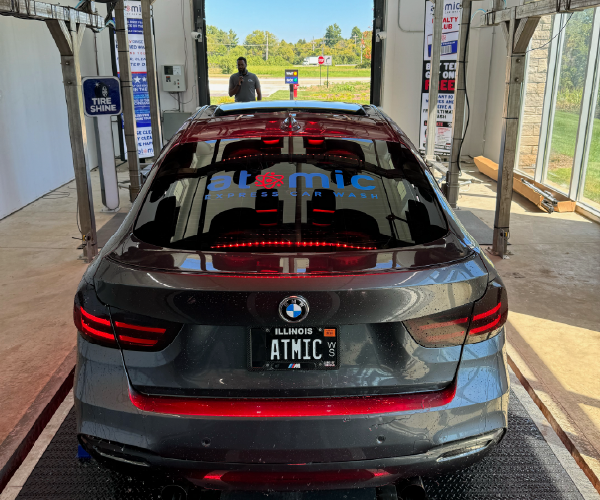
Last(ing) Impressions
April 3, 2025
8 minute ReadThe importance of providing members a good exit when they cancel — so you can win them back.
By Tom Gresham
When members cancel their subscription to a car wash, it may not seem like an opportunity, but that’s the way many successful operators see it. It’s a chance to learn about themselves, their customers and to strengthen their relationship with a familiar customer who already knows them.
Bobby Thomson, CEO of Retention Express, said the focus in the car wash industry on selling memberships on the front end is obviously critical to long-term success, but “the back door of how people leave is equally important, if not more important. It costs 5-25 times more to acquire new customers than to retain the ones you have.”
“If that exit is difficult, then it can really hurt a reputation for a brand,” Thomson said. ““If you make the exit clean for a member, with understanding and minimal friction, it has been proven that there is a greater chance they will come back.” Perhaps it will be as a transactional customer or they might even sign back on with an unlimited subscription if their circumstances change.
The stakes for a smooth exit are clear — and significant, according to Braxton McKee, ecommerce team lead at Rinsed.
“A poorly managed exit can lead to negative word-of-mouth, damage to brand reputation and a permanent loss of customers,” McKee said. “On the other hand, a thoughtful and empathetic exit process can leave the opportunity for future business, and maintain goodwill, even if the hiatus is temporary. The way a consumer feels about the entire departure experience will make or break the possibility of reengagement or if they’ll recommend the service to others.”
An easy — even pleasant — exit
From the outset, the process for canceling a membership should be straightforward and painless.
“What is that last impression that you want to leave with your customer?” Thomson said. “Do you want that exit experience to have been painful, frustrating and difficult and they're leaving on a sour note? Or do you want to make that process seamless, interactive, engaging, appreciative, thankful for their business and leaving them with a really good experience?”
Washes should avoid “aggressive” responses to a cancellation that make for a difficult or unpleasant experience or they will risk ending a relationship that is not actually over yet, said Max Pulcini, senior director of marketing and communications for EverWash.
“You want to make sure that when you do reach back out via an email, a text message, a push notification, that the first thing they think about is, ‘I really did love that service when I was a member’ and not, ‘Man, it was really a pain in the butt to cancel. I don't want to go through that again,’ or ‘I had a really nasty experience on the way out, and I don't really want to give that company my money again,’” he said.
Kayla Ivey, product marketing manager, DRB, noted that members cancel for a variety of reasons that are often outside of a wash’s control, such as reducing their expenses, subscription fatigue or not washing often enough to find value in a membership, but that doesn’t mean they are leaving the brand behind — unless they are pushed away.
“Making it difficult for them to leave isn’t likely to make them stay, but it may make them reconsider patronizing your wash in the future,” Ivey said.
In today’s climate, Thomson believes an effective exit process means allowing members to choose how to cancel.
“You want to give them various options in terms of how to cancel,” Thomson said. “Some people want that empowerment to simply cancel online, but others want to speak to someone to make sure they know how long they can use the wash on their membership or to provide their feedback.”
McKee noted that the Federal Trade Commission’s “Click-to-Cancel” rule has begun to limit retailers’ cancellation processes, requiring them to be as simple and straightforward as the signup process. The role of team members in the process also should not be overlooked.
“Ensure your staff are trained to handle exits with understanding and a true focus on the customer’s perspective,” McKee said. “Nothing is more off putting than an employee who accepts a cancellation at face value, seeing the customer as just another number in the POS. Staff should be prepared to offer to salvage the relationship at the moment if possible.”

Understanding the cancellation
When you have the resources in place to find out why someone canceled their membership, it often will prove illuminating.
Michael Pelikan, director of operations of Retention Express, said those brands that consistently engage with customers, such as in the case of a canceled membership, “are truly separating themselves in the industry versus certain brands that may just take it in as a transactional cancellation.”
“Oftentimes, we see that people really do identify with these car wash brands— they know the attendants on site, they know the managers, they have that additional personal connection,” Pelikan said. “And so when they do exit, they don't want to feel just like a transaction or another number. They want to get a reply noting that they're going to be missed, that we appreciated their business, that we hope to see them back as a retail member.”
Pelikan said identifying the specifics of why a customer cancels their membership also helps identify problems that need attention to prevent future problems and cancellations.
McKee said exit feedback data too often is not used to its fullest potential because operators receive only a broad reason for a customer’s departure — such as “Dissatisfied with Service” — but fail to get specifics so that they can address the reason.
“I always recommend collecting one more piece of feedback to obtain a better understanding,” he said. “This can be as simple as an open response asking the customer to provide anything they’d like, which may suffice for a smaller operator who sees less than 50 cancellations a month. But, larger operators with hundreds of locations might see thousands of cancellations a month, even with an industry average churn rate. In that case, having canned second questions to capture a clearer feedback picture will be more efficient in digesting the data.”
Remember retail …
A common missed opportunity in the industry is not seeking exit feedback from defecting retail wash traffic — not just subscription members, McKee said.
“The industry has experienced dramatic declines in retail [transactional] wash volume, as recent as 2024 Q4,” he said. Retail revenue has also declined, with the Q4 2024 Car Wash Industry Report released by Rinsed showing a decrease of 7.1% year-over-year. “The operator’s ultimate goal is to convert retail into subscriber consumers. This means the operator needs to retain every retail washer they can to have maximum conversion,” McKee said.
Ivey said members that cancel their subscriptions often remain customers — in fact, she said, “we’ve seen that about 70% of canceled members will continue to purchase single washes at the wash where they were previously a member.”
“It’s important to consider what value you can offer your retail customers that does not involve selling them a membership,” Ivey said. “Consider implementing a loyalty program that rewards them for their purchases and drives visit frequency. You might also consider retail-oriented specials such as gift card deals or wash books with a broad customer reach.”
Ivey said the car wash industry’s heavy focus on memberships means that operators often overlook retail-oriented strategies, noting that too many membership promotions can lead to higher churn and a drop in member lifetime value.
“The most successful strategies balance a focus on memberships with tactics intended solely to drive more retail business,” Ivey said.
Recapture campaigns
The effort to win back a member who is canceling can begin immediately. In fact, offering a customer a discount at the time of cancellation can help keep them, with some operators saving as many as 10% of their exits “by automating an offer and value propositions to a member at the time of cancellation,” McKee said.
“For example, allow a customer to stay active and receive a 25% discount for the next three months, then return to normal pricing,” he said. “Customers who accept a downsell yield tremendous effects regarding [customer lifetime value] and stickiness. Believe it or not, this is a net positive for your business — don’t overthink the temporary reduction in ticket value.”
Experts agreed that washes should employ a strategic approach to winning members back via digital marketing, using messaging that is tailored to individual customers as much as possible. The campaign should not overwhelm customers but there should be a cadence of planned messaging that reaches them in the short-, medium- and long-term.
Ivey said a must-have element of a successful winback campaign is a marketing platform that recognizes when a member has churned out of a plan and automatically places them into a “drip campaign.”
“Finding a platform synced with your point-of-sale ensures this all happens automatically so you don’t miss any potential opportunities,” Ivey said. “The platform should then automatically wait for a preestablished period of time before sending a series of messages attempting to win the customer back.”
In addition to ongoing winback efforts, Pulcini said washes should create large-scale promotions focused on previous members during special, targeted occasions throughout the year.
“Make sure that you’re taking advantage of those seasonal moments — what are the times of the year that consumers are looking for a deal and how can you inject your car wash into that regular shopping routine and habit,” Pulcini said.
Pulcini noted that the cost of acquisition for previous customers is “pennies” compared to the cost of acquiring new customers, and washes should look past the immediate costs of winback efforts and focus on the long-term gains that add to customers’ lifetime values.
“You're tapping into people who know where you're located, they know what your service is all about, they know how much it costs,” Pulcini said. “So the amount of effort and resources that go into targeting winbacks is minuscule compared to going out there and trying to acquire new customers and new business. That’s a big reason why this is such an important thing for washes.”







